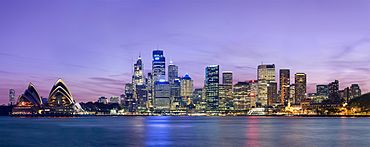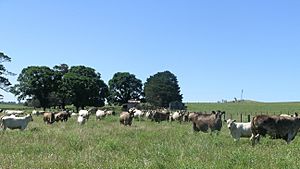Economy of New South Wales facts for kids
The economy of New South Wales (NSW) is a very important part of Australia's overall economy. In 2016–17, it was worth about $557.9 billion. This means it makes up about one-third (33.0%) of Australia's total GDP. GDP is a way to measure the total value of all goods and services produced in a region.

The Sydney Opera House and CBD at dusk from Jeffrey Street, Kirribilli in December 2008.
|
|
| Currency | Australian Dollar (A$ or AUD) |
|---|---|
| 1 July - 30 June | |
| Statistics | |
| GDP | A$557.9 billion - 2016/17 |
|
GDP growth
|
2.9% (2016-17) |
|
GDP per capita
|
A$67,841 (2016/17) |
| Unemployment | 4.6% (December 2017) |
|
Main industries
|
Services, mining, industrial and transportation equipment, food processing, chemicals, steel |
| External | |
| Exports | A$60.4 billion (2008-2009) [1] |
|
Export goods
|
coal, Aluminium, Refined petroleum, Copper ores & concentrates, Medicaments (incl veterinary), iron ore, wheat, machinery and transport equipment |
|
Main export partners
|
|
| Imports | A$100.8 billion (2008-2009) |
|
Import goods
|
Medicaments (incl veterinary), Telecom equipment & parts, Passenger motor vehicles, Crude petroleum, Computers, Refined petroleum, Monitors, projectors & TVs, Office machines, Goods vehicles, Medical instruments (incl veterinary) |
|
Main import partners
|
|
|
All values, unless otherwise stated, are in US dollars. |
|
Contents
What Makes NSW's Economy So Big?
New South Wales has the largest economy in Australia. It was worth $558 billion in 2016-17. This is about 33% of Australia's total GDP. Sydney, the capital city of NSW, makes up almost one-quarter of Australia's GDP by itself.
The economy of NSW is larger than the entire economies of countries like South Africa, Thailand, Malaysia, Colombia, the Philippines, or Ukraine. This shows how strong and important it is.
NSW has a very diverse economy. This means it doesn't rely on just one type of business. It has many different industries that use knowledge and new ideas.
Key Industries in NSW
NSW is a leader in many important industries in Australia.
- It handles 46% of Australia's finance and insurance business.
- It has 39% of the property and business services industry.
- It produces 50% of Australia's film and television shows.
- It manages 33% of the communications industry.
- It contributes 33% of the manufacturing industry.
NSW also has the biggest manufacturing industry in Australia. In 2005–06, it added $31.4 billion to the state's economy.
Global Business Hub
Many international companies choose NSW for their main offices in the Asia Pacific region. More than 65% of all regional headquarters in Australia are located here. That's over 600 companies!
NSW is also a big center for customer service. About 600 contact center companies operate here. They have 60,000 workstations, which is 42% of all contact centers in Australia. If a company needs a contact center that speaks many languages, 32% of those in the Asia Pacific are in NSW.
Sydney's financial services industry is huge. It's almost half the size of London's and more than one-third the size of New York City's.
Leading the Way in Australia
NSW is home to a large share of Australia's key businesses:
- 81% of Asia Pacific finance and insurance regional offices.
- 80% of Australian and foreign bank headquarters.
- 73% of property and business services regional offices.
- 60% of manufacturing regional headquarters.
- 76% of all information and communications technologies (ICT) regional headquarters.
- 46% of all ICT businesses.
- 80% of large international pharmaceutical companies in Australia.
- About 48% of the total value of ASX listed biotechnology companies. These 41 companies are worth $11.65 billion.
Growing Economy
NSW is a popular place to start new businesses. In 2005–06, almost 39,000 new companies registered in NSW. This was more than in Victoria (38,000) and Queensland (fewer than 25,000).
Overall, NSW has many more companies than other states. Over 510,000 companies are registered in NSW. This is almost 50,000 more than in Victoria and 269,000 more than Queensland.
Exports from NSW
NSW sells many goods and services to other countries. In 2005-06, NSW made $17.4 billion from services exported. This was 42% of Australia's total service exports.
That same year, NSW exported over $44 billion worth of goods and services. The top five exports were:
- Travel services (19%): This includes things bought by tourists and foreign workers.
- Coal and coke (11.4%).
- Transportation services (7.5%): Like shipping goods and travel for non-residents.
- Non-ferrous metals (5.4%): Mostly copper and aluminium.
- Metal ores and metal scrap (4.7%).
In 2005-06, NSW also exported $26.8 billion worth of manufactured goods. This was a 16.5% increase from the year before.
Agriculture in NSW

Farming happens all over New South Wales, except in the very dry western part. Cattle, sheep, and pigs are the main types of livestock raised in NSW. These animals have been here since the first Europeans arrived. NSW is the most important state for farming in Australia. It has about one-third of the country's sheep, one-fifth of its cattle, and one-third of its pigs.
New South Wales grows a lot of Australia's hay, fruit, legumes, maize, nuts, wool, wheat, oats, and oilseeds (about 51%). It also produces a lot of poultry, rice (about 99%), and vegetables. Fishing, including oyster farming, and forestry, which includes wood chips, are also important. Bananas and sugar are mainly grown near the Clarence, Richmond, and Tweed Rivers.
Wool, lambs, and beef cattle are produced in the Northern Tablelands. The cotton industry is mostly in the Namoi Valley in north-western NSW. In the central slopes, there are many orchards that grow apples, cherries, and pears.
There are about 40,200 hectares of vineyards in the eastern part of the state. Wines are made in the Hunter Valley, and the Riverina region is the biggest wine producer in NSW. Australia's largest and most valuable area for breeding Thoroughbred horses is centered around Scone in the Hunter Valley.

